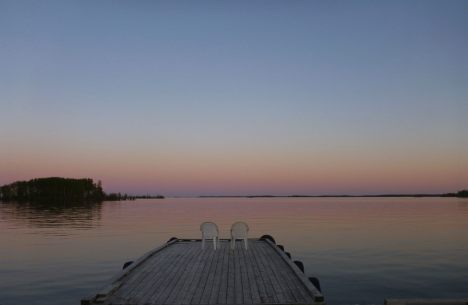

As part of our field work to measure carbon emissions in burned areas, we often have to hike through an obstacle course of fallen trees to reach our research sites. I took some video with a GoPro to give a sense of what this is like, as well as how we extract soil to take measurements and how we find the perfect sites.
Elizabeth Wiggins is a PhD student in the department of Earth System Science at the University of California, Irvine.
One of the best parts of a field campaign are the ‘little moments’ that sneak in while you work. They can really make your day. On that front this field campaign has been no slouch. Yesterday for example, we saw a juvenile black bear while we were traveling to a new field site. We also enjoyed a great sunset over Lake La Ronge here in Saskatchewan, and had a beaver sighting later that evening.

The great sunset the team enjoyed over Lake La Ronge on June 5. (Credit: Dieleman)
However, for me one of the best ‘little moments’ happened the day before… Our team is split into a number of different groups that measure different ecosystem characteristics: fire severity, tree density, species and age, as well as soil horizons and depth of burn in the soil. Liz Wiggins and myself work together to collect the soil measurements. As we measure and collect samples from every organic soil horizon, this task can take some time — often causing the soils group to finish up well after the rest of the team. Saturday though, everything came together for us soil diggers, and for the first time on this campaign our little group finished up first. We thought it was worth a victory photo. Sometimes it is the little things.
That Saturday was a particularly eventful day for the whole team. We had a great opportunity to participate in the filming of CBC’s The Nature of Things. Everyone was a pleasant combination of excited with a touch of nerves to be filmed, but generally thrilled to be sharing our science in this medium. The whole filming crew was wonderful, and eased us through the whole process. The sneak peek of the drone footage they shot seemed pretty promising to us, but we will all have to wait till 2017 to see the final footage. I guess some days in the field it is the big things too.
Catherine Dieleman is a post-doctoral researcher in Ecosystem Science at the University of Guelph in Ontario, Canada